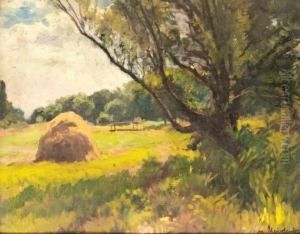Jeno Marothi Paintings
Jenő Maróti was a Hungarian sculptor and medalist, born on June 24, 1875, in Szeged, Hungary. He was known for his neoclassical style, which incorporated elements of Art Nouveau and symbolism, making him a prominent artist in the early 20th century.
Maróti studied at the School of Applied Arts in Budapest and later at the Julian Academy in Paris, where he was influenced by the work of French sculptors and the burgeoning Art Nouveau movement. His early work showed a strong academic foundation, but as the new century progressed, his style evolved to include more fluid lines and stylized forms characteristic of Art Nouveau.
Around the turn of the century, Maróti began to gain international recognition. He won a gold medal at the 1900 Paris World Exposition for his statue 'Aphrodite', which showcased his ability to blend classical themes with modern aesthetics. He was also commissioned to create several public monuments and sculptures, including the monument for Kossuth Lajos in Budapest and various decorative works for the Hungarian Parliament building.
Maróti's work extended beyond sculpture; he was also a proficient medalist and designer. He created numerous medals, plaques, and coins, some of which were used as Hungarian currency during his lifetime. Additionally, he designed furniture and other decorative objects, contributing to the interior design of prominent buildings in Hungary.
Despite the widespread appreciation for his art, Maróti's career was affected by the political turmoil in Europe. After World War I, the changing political landscape in Hungary influenced the themes and reception of his art. Nevertheless, he continued to work until his death in Budapest on May 6, 1945.
Maróti's legacy lies in his contribution to Hungarian and European sculpture, particularly in his ability to harmonize classical and modern elements. His works are still admired for their beauty and craftsmanship, and they remain an important part of Hungary's cultural heritage.






